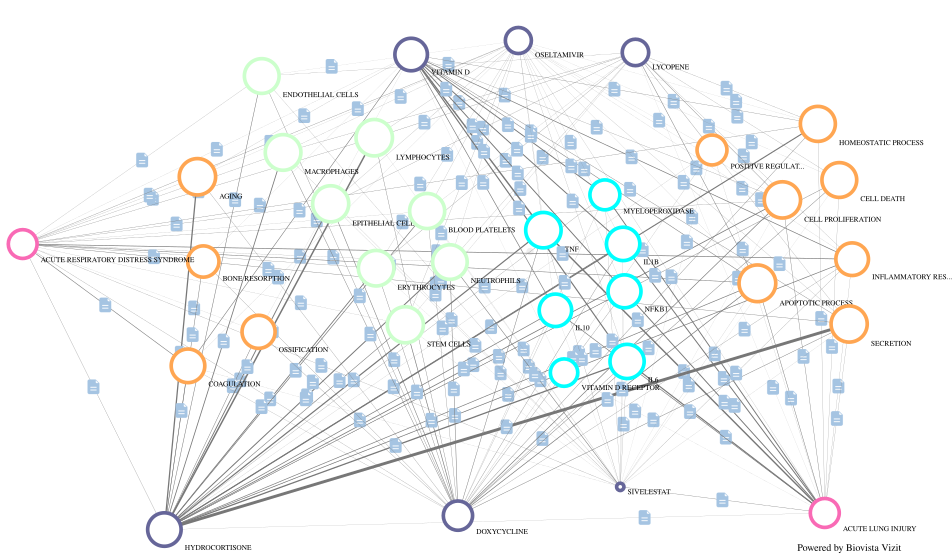A different paradigm
The current COVID-19 pandemic from the SARS-CoV-2 virus infection requires all of us to think and act out of the box in order to respond to this global challenge effectively and expeditiously.
Here, we share a component of our Project Prodigy AI, called Biovista Vizit. Vizit helps researchers generate hypotheses and test their validity using published research. We have used Biovista Vizit to create visual networks of connections between different attack points related to COVID-19, including drugs, genes, pathways, cell types and more.
Our aim is to contribute to the understanding of the disease and the rapid development of possible treatments by:
- exploring the biology around the disease
- generating hypotheses for possible treatment
- sharing hypotheses with the community
- assessing and refining these hypotheses
AI – Quick intro to Biovista Vizit
Biovista Vizit is an AI tool that helps researchers generate hypotheses and test their validity using published research. With Vizit you explore associations bewteen biological entities such as genes, pathways, diseases and more. These associations are dispalyed as a graph, with the entities shown as nodes in the graph and their associations as links between nodes. Supporting scientific literature (PubMed articles) can be viewed by clicking on the blue document icons.
Biovista Vizit graphs are “live”, meaning that the user may explore additional biological entities (e.g. Genes, Cell Types, Pathways, Adverse Events, Diseases etc.) of their choice and map the links between them. Vizit graphs can also be shared with collaborators and the research community.
Starting Points
We share here, with the community, two Biovista Vizit graphs that we have built to date. Clicking on these graphs will take you straight into the Vizit environment. Feel free to use these as a starting point to assess and expand on our findings or to create your own hypotheses.
Graph 1: Focus on the disease and virus biology: ACE2, TMPRSS2, Acute Lung Injury, ARDS, and Lung Fibrosis.
Graph 2: Focus on novel treatments – Drug Repositioning. Finding existing drugs that alone or in combination could be used against COVID-19.
Our hypotheses so far
To attack the virus and address COVID-19 symptoms we are focusing Project Prodigy initially on:
- viral entry in the host cell, e.g. the Angiotensin Converting Enzyme 2 (ACE2) Receptor and the TMPRSS2 transmembrane protease
- down-stream inflammatory cytokine release syndrome (CRS) that results in severe COVID-19. Against this biology, we are repositioning drugs on a large scale and in a systematic way.
Currently there are no available therapies for COVID-19, or for other coronavirus infections, other than for symptoms. Growing evidence suggests that there are several biological elements that likely contribute to disease progression, such as Acute Respiratory Distress Syndrome (ARDS), lung injury, lung fibrosis and inflammation, which may explain the variety of symptoms. It seems that an optimal treatment plan would have to consist of either a combination of drugs, or a single drug that can address most/all issues. The most efficient process to begin to find new potential therapies is drug repositioning (DR). DR generates hypotheses that need testing about existing drugs used to treat other diseases now having the potential to treat COVID-19.
Project Prodigy is working through more than 170,000 putative Drugs, Compounds and Nutritional Supplements, DIRECTLY or INDIRECTLY linked to the COVID-19 targets above. So far, we hypothesize that two (2) drugs and (2) Nutritional Supplements that could be co-administered with the drugs seem to be suitable for further study and testing. Our hypothesis is based on the mechanism of action of these initial drugs and supplements that may help manage the disease and improve the overall quality of life of COVID-19 patients, including those with pre-existing comorbidities.
As our AI and our team identify new hypotheses, we will keep refining our graphs and selection of drugs and bioactives. We will post updates as we improve.
Please contact us to receive our White Paper discussing our current hypotheses and drugs.




 vs COVID-19
vs COVID-19
